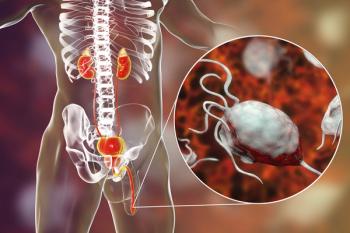
Oncology NEWS International
- Oncology NEWS International Vol 7 No 7
- Volume 7
- Issue 7
3D Conformal RT Equal to Surgery for Early Stage Prostate Cancer
ANN ARBOR, Michigan--The typical candidate for radical prostatectomy does at least as well with three-dimensional (3D) conformal radiation therapy for early-stage prostate cancer, results of a University of Michigan study suggest. Findings in 172 consecutively treated patients showed a 95% actuarial survival 8 years after radiation therapy and an 85% rate of freedom from biochemical failure.
ANN ARBOR, Michigan--The typical candidate for radical prostatectomy does at least as well with three-dimensional (3D) conformal radiation therapy for early-stage prostate cancer, results of a University of Michigan study suggest. Findings in 172 consecutively treated patients showed a 95% actuarial survival 8 years after radiation therapy and an 85% rate of freedom from biochemical failure.
"I think these results are at least comparable to those reported after radical prostatectomy," Howard Sandler, MD, associate professor of radiation oncology, University of Michigan, said at the ASCO integrated symposium on prostate cancer.
Typical Prostatectomy Patient
The primary purpose of the study was to evaluate outcome with radiation therapy in patients whose clinical and demographic characteristics resemble those of prostatectomy patients, as gleaned from published surgical series. Dr.Sandler said the literature indicates that the typical prostatectomy patient is age 60 to 65, has a Gleason score of 7 or less, and a PSA level less than 10 ng/ml.
"A sample of the reported 10-year freedom from biochemical recurrence for these types of patients shows a range from about 50% to 75%," Dr. Sandler said.
A patient whose PSA level exceeds 10 has a 75% chance of having cancer penetration into the seminal vesicles or lymph nodes, he said. In prostatectomy series, about two-thirds to three-fourths of patients have a PSA level of 10 or less. Historically, about 60% of radiation therapy candidates at the University of Michigan have had PSA levels that exceeded 10.
To try to compare results of surgery and radiation therapy outside the context of a randomized clinical trial, investigators evaluated their experience with 3D conformal radiation in patients who fit the criteria for prostatectomy. The 172 patients had stage T1-T2 cancer, pretreatment PSA levels of 10 ng/mL or less, a Gleason score of 7 or less, and age of 70 or younger.
Dr. Sandler and his colleagues defined biochemical failure as three consecutive rises in PSA level after treatment.
All patients in the series had CT scans while immobilized in the treatment position, which was supine in most cases. Customized blocking was used in each patient, and treatment plans provided four-dose symmetric coverage.
The median radiation dose delivered to the patients was 69 Gy. A gradual dose escalation occurred over the course of the study, which involved patients treated between 1986 and 1997.
Dr. Sandler said that 16% of the patients had a total dose greater than 73.8 Gy. (The trend in 3D conformal radiation is toward even higher doses, he said, noting that the current dose employed at the University of Michigan is between 75 and 77 Gy.)
The median age of the patients was 65, and the median PSA level was 5.3 ng/ml. The median follow-up was 3 years, and 18% of the patients have been followed for 5 to 10 years.
Four deaths have occurred, none related to prostate cancer, resulting in an overall survival of about 95%, Dr. Sandler said. Freedom from PSA failure was 85% at both 5 and 8 years of follow-up.
Influence of Gleason Score
The likelihood of failure-free survival was influenced by baseline Gleason score, as patients with Gleason scores of 2 to 6 did better than those with Gleason 7. In fact, Gleason score was the only significant predictor of biochemical failure. Patients who had a Gleason score of 7 had a relative risk of biochemical failure of 4.9 (p = .02), compared to patients with Gleason scores of 2 to 6.
"The results are encouraging at 8 years," Dr. Sandler said. "However, we are using biochemical freedom from relapse as an outcome variable. Whether this will turn into a useful surrogate for survival remains to be determined.
Dr. Sandler believes that future results with 3D conformal radiotherapy will be better than those currently reported in this study "because androgen ablation is being used in a neoadjuvant fashion to try to improve the results of external beam radiation."
Higher Doses
Also, he said, "the radiation dose were using today is quite a bit higher than when we started using 3D conformal radiation therapy, and we are seeing patients at earlier and earlier stages."
Whether the use of 3D conformal radiation will result in real improvement in tumor control and decreased prostate cancer mortality remains to be seen, he said, "but patients who present with lower PSAs clearly have a better freedom from biochemical recurrence after external beam therapy."
Articles in this issue
over 27 years ago
Calling the National Cancer Instituteover 27 years ago
Six Cycles of AT Found Safe in Advanced Breast Cancerover 27 years ago
New Drug Promising in Advanced Pancreatic Cancerover 27 years ago
Herceptin/Chemo Effective in Metastatic Breast Cancerover 27 years ago
Virtual Reality Exhibit Simulates Cancer Fatigueover 27 years ago
New Director of AIDS Researchover 27 years ago
Exhibit Explores Healing Power of Creating Artworkover 27 years ago
Update on Trials of Thrombopoietin for Platelet Recoveryover 27 years ago
Amifostine Reduces Xerostomia After RT for Head and Neck Cancerover 27 years ago
National Survey Documents Gap in Quality of HIV/AIDS CareNewsletter
Stay up to date on recent advances in the multidisciplinary approach to cancer.


















































































